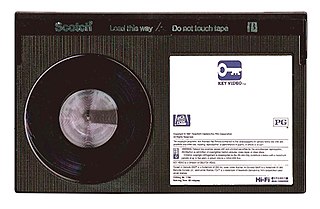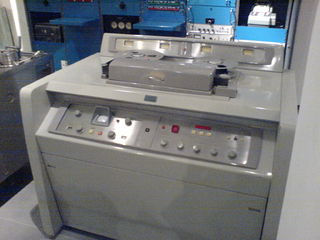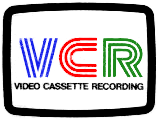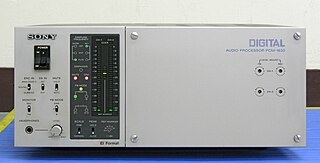
Video is an electronic medium for the recording, copying, playback, broadcasting, and display of moving visual media. Video was first developed for mechanical television systems, which were quickly replaced by cathode-ray tube (CRT) systems which, in turn, were replaced by flat panel displays of several types.

VHS is a standard for consumer-level analog video recording on tape cassettes invented in 1976 by the Victor Company of Japan and was the competitor to the ill-fated Sony Betamax system.

Videotape is magnetic tape used for storing video and usually sound in addition. Information stored can be in the form of either an analog or digital signal. Videotape is used in both video tape recorders (VTRs) and, more commonly, videocassette recorders (VCRs) and camcorders. Videotapes have also been used for storing scientific or medical data, such as the data produced by an electrocardiogram.

S-VHS (スーパー・ヴィエイチエス), the common initialism for Super VHS, is an improved version of the VHS standard for consumer-level video recording. Victor Company of Japan introduced S-VHS in Japan in April 1987, with their JVC-branded HR-S7000 VCR, and in certain overseas markets soon afterward. By the end of 1987, the first S-VHS VCR models from other competitors included Hitachi VT-2700A, Mitsubishi HS-423UR, Panasonic PV-S4764, RCA VPT-695HF, and Toshiba SV-950. It has been standardized as IEC 60774-3 and IEC 60774-4.

Betamax is a consumer-level analog recording and cassette format of magnetic tape for video, commonly known as a video cassette recorder. It was developed by Sony and was released in Japan on May 10, 1975, followed by the US in November of the same year.

Video 2000 is a consumer videocassette system and analogue recording standard developed by Philips and Grundig to compete with JVC's VHS and Sony's Betamax video technologies. It was designed for the PAL color television standard, but some models additionally handled SECAM. Distribution of Video 2000 products began in 1979 exclusively in Europe, South Africa and Argentina and ended in 1988.
Betacam is a family of half-inch professional videocassette products developed by Sony in 1982. In colloquial use, "Betacam" singly is often used to refer to a Betacam camcorder, a Betacam tape, a Betacam video recorder or the format itself.

A video tape recorder (VTR) is a tape recorder designed to record and playback video and audio material from magnetic tape. The early VTRs were open-reel devices that record on individual reels of 2-inch-wide (5.08 cm) tape. They were used in television studios, serving as a replacement for motion picture film stock and making recording for television applications cheaper and quicker. Beginning in 1963, videotape machines made instant replay during televised sporting events possible. Improved formats, in which the tape was contained inside a videocassette, were introduced around 1969; the machines which play them are called videocassette recorders.

Video Cassette Recording (VCR) is an early domestic analog recording format designed by Philips. It was the first successful consumer-level home videocassette recorder (VCR) system. Later variants included the VCR-LP and Super Video (SVR) formats.

The videotape format war was a period of competition or "format war" of incompatible models of consumer-level analog video videocassette and video cassette recorders (VCR) in the late 1970s and the 1980s, mainly involving the Betamax and Video Home System (VHS) formats. VHS ultimately emerged as the preeminent format.

The 8mm video format refers informally to three related videocassette formats. These are the original Video8 format and its improved successor Hi8, as well as a more recent digital recording format known as Digital8. Their user base consisted mainly of amateur camcorder users, although they also saw important use in the professional television production field.

U-matic is an analogue recording videocassette format first shown by Sony in prototype in October 1969, and introduced to the market in September 1971. It was among the first video formats to contain the videotape inside a cassette, as opposed to the various reel-to-reel or open-reel formats of the time. The videotape is 3⁄4 in (19 mm) wide, so the format is often known as "three-quarter-inch" or simply "three-quarter", compared to open reel videotape formats in use, such as 1 in (25 mm) type C videotape and 2 in (51 mm) quadruplex videotape.
Film-out is the process in the computer graphics, video production and filmmaking disciplines of transferring images or animation from videotape or digital files to a traditional film print. Film-out is a broad term that encompasses the conversion of frame rates, color correction, as well as the actual printing, also called scannior recording.

1–inch Type C is a professional reel-to-reel analog recording helical scan videotape format co-developed and introduced by Ampex and Sony in 1976. It became the replacement in the professional video and broadcast television industries for the then-incumbent 2–inch quadruplex videotape open-reel format. Additionally, it replaced the unsuccessful type A format, also invented by Ampex, and, primarily in mainland Europe, it supplemented the type B format, invented by the Fernseh division of Bosch, but it was replaced by type C format also there.

A PCM adaptor is a device that encodes digital audio as video for recording on a videocassette recorder. The adapter also has the ability to decode a video signal back to digital audio for playback. This digital audio system was used for mastering early compact discs.

2-inch quadruplex videotape was the first practical and commercially successful analog recording video tape format. It was developed and released for the broadcast television industry in 1956 by Ampex, an American company based in Redwood City, California. The first videotape recorder using this format was built the same year. This format revolutionized broadcast television operations and television production, since the only recording medium available to the TV industry until then was kinescope film.

Betamovie is the brand name for a range of consumer grade camcorders developed by Sony for the Betamax format. By "camcorder" is understood a single unit comprising a video camera and a video recorder.

The 1/4 inch Akai is a portable helical scan EIA and CCIR analog recording video tape recorder (VTR) with two video record heads on the scanning drum. The units were available with an optional RF modulator to play back through a TV set, as well as a detachable video monitor. The Akai Electric Ltd. VTR plant was in Tokyo, Japan.

Compact Video Cassette (CVC) was one of the first analog recording videocassette formats to use a tape smaller than its earlier predecessors of VHS and Betamax, and was developed by Funai Electronics of Japan for portable use. The first model of VCR for the format was the Model 212, introduced in 1980 by both Funai and Technicolor as they had created a joint venture to manufacture and introduce the format to the home movie market. The system, which included the VCR and a hand held video camera, was very small and lightweight for its time.

A videocassette recorder (VCR) or video recorder is an electromechanical device that records analog audio and analog video from broadcast television or other source on a removable, magnetic tape videocassette, and can play back the recording. Use of a VCR to record a television program to play back at a more convenient time is commonly referred to as timeshifting. VCRs can also play back prerecorded tapes. In the 1980s and 1990s, prerecorded videotapes were widely available for purchase and rental, and blank tapes were sold to make recordings.


















